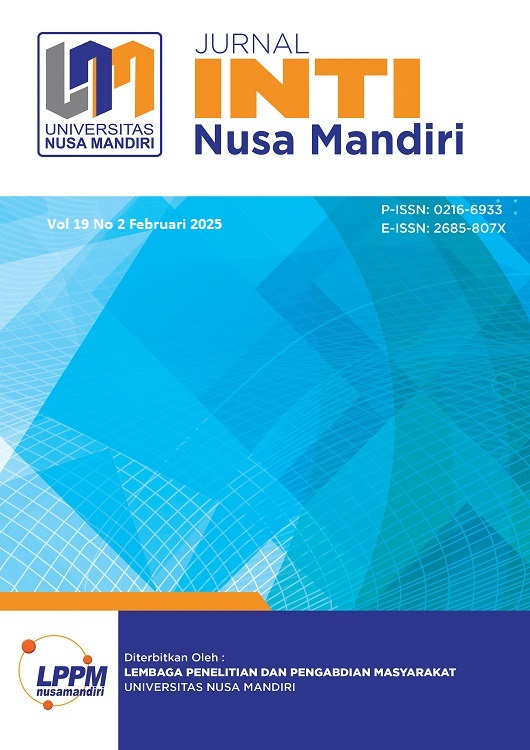PENDEKATAN HYBRID TSR-NN UNTUK PERAMALAN INFLOW OUTFLOW UANG KARTAL REGIONAL JAWA TIMUR
DOI:
https://doi.org/10.33480/inti.v19i2.5283Kata Kunci:
hybrid TSR-NN, MAPE, RMSE, TSRAbstrak
The availability of currency circulating in society can influence the economic conditions of a country. The need for money increases when religious holidays approach, such as Eid al-Fitr and Christmas, as well as school holidays and the end of the year. Therefore, it is necessary to plan the need for currency, one of which is by forecasting the circulation of currency, both inflow and outflow. Forecasting is done to predict a value in the future based on historical data. This research aim was to predict the inflow and outflow of regional currency in East Java using the hybrid Time Series Regression (TSR) – Neural Network (NN) method. The methods in time series analysis used to predict are increasingly developing, as are hybrid methods, namely methods that combine several models to produce more accurate forecasts. The analysis results obtained show that the prediction of incoming and outgoing cash flows is better using the hybrid TSR-NN method because it produces a smaller RMSE value, namely 1,656.62, with a MAPE of 0.28 compared to the TSR method. The results of this study are expected to contribute to a hybrid approach for forecasting the regional currency inflow and outflow of East Java.
Unduhan
Referensi
Arumsari, M., Tri, A., & Dani, R. (2021). Peramalan Data Runtun Waktu menggunakan Model Hybrid Time Series Regression – Autoregressive Integrated Moving Average. 02(01), 1–12.
Astri, D., Kuswanto, H., & Suhartono. (2020). PERAMALAN LANGSUNG DAN TIDAK LANGSUNG MARKET SHARE MOBIL MENGGUNAKAN ARIMAX DENGAN EFEK VARIASI KALENDER. Media Statistika, 13(1), 47–59. https://doi.org/10.14710/medstat.13.1.47-59
B.S., W., & Prastuti, M. (2022). Peramalan Permintaan Semen di PT. XYZ Menggunakan. Jurnal Sains Dan Seni ITS, 11(1).
Dani, A. T. ., Fauziyah, M., Sandariria, H., & A’yun, Q. . (2023). Forecasting The Search Trends of The Keyword “ Sarung Wadimor ” In Indonesia on Google Trends Data Using Time Series Regression with Calender Variation and Arima Box- Jenkins. Jurnal Matematika, Statistika Dan Komputasi, 19(3), 447–459. https://doi.org/10.20956/j.v19i3.24551
Desi, D., Rizki, S. W., & Yundari, Y. (2022). Combined Model Time Series Regression – ARIMA on Stocks Prices. Tensor, 3(2), 65–72.
Hadwan, M., Al-maqaleh, B. M., Al-badani, F. N., Khan, R. U., & Al-hagery, M. A. (2022). A Hybrid Neural Network and Box-Jenkins Models for Time Series Forecasting. Computer, Materials &Continua, 70(3). https://doi.org/10.32604/cmc.2022.017824
Hyndman, R. J., & Athanasopoulos, G. (2018). Forecasting : Principles and Practice (2nd ed.). Otexts. https://otexts.com/fpp2/
Idhom, B., Louzazni, M., & Bouardi, A. El. (2020). A hybrid ARIMA – ANN method to forecast daily global solar radiation in three different cities in Morocco. The European Physical Journal Plus, 135(11), article id.925. https://doi.org/10.1140/epjp/s13360-020-00920-9
Idhom, M., Fauzi, A., Trimono, T., & Riyantoko, P. (2023). Time Series Regression : Prediction of Electricity Consumption Based on Number of Consumers at National Electricity Supply Company. TEM Journal, 12(3), 1575–1581. https://doi.org/10.18421/TEM123
Indonesia, B. (2024). Pengelolaan Uang Rupiah Perencanaan Pencetakan Pengeluaran. https://www.bi.go.id/id/fungsi-utama/sistem-pembayaran/pengelolaan-rupiah/default.aspx
Indrasetianingsih, A., Pramesti, W., Fitriani, F., Reihana, H., Sari, K., & Priyanto, H. D. (2023). Peramalan Peredaran Inflow dan Outflow Uang Kartal Regional Jawa Timur dengan Menggunakan Metode Regresi Time Series. Prosiding Seminar Nasional Hasil Riset Dan Pengabdian, 1–13.
Kamadewi, R., & Achmad, A. I. (2021). Pemodelan Hybrid ARIMA ( Autoregressive Integrated Moving Average ) – ANN ( Artificial Neural Network ) pada Data Inflasi Indonesia Tahun 2009 - 2020. Prosiding Statistika, 33–41. https://karyailmiah.unisba.ac.id/index.php/statistika/article/view/25503/0
Maghfiroh, Z. F., Suhartono, Prabowo, H., Salehah, N. A., Prastyo, D. D., & Setiawan. (2021). Forecasting Inflow and Outflow of Currency in Central Java using ARIMAX, RBFN and Hybrid ARIMAX-RBFN. Journal of Physics: Conference Series, 1863(1), 0–19. https://doi.org/10.1088/1742-6596/1863/1/012066
Qadrini, L., Asrirawan, A., Mahmudah, N., Fahmuddin, M., & Amri, I. F. (2020). Forecasting Bank Indonesia Currency Inflow and Outflow Using ARIMA, Time Series Regression (TSR), ARIMAX, and NN Approaches in Lampung. Jurnal Matematika, Statistika Dan Komputasi, 17(2), 166–177. https://doi.org/10.20956/jmsk.v17i2.11803
Ramadani, K., Wahyuningsih, S., & Hayati, M. N. (2022). Forecasting stock price PT. Telkom using hybrid time series regression linear–autoregressive integrated moving average. 18(2), 293–307. https://doi.org/10.20956/j.v18i2.18837
Tri, A., Dani, R., Putra, F. B., & A, Q. Q. (2023). Red Chili Price Forecasting in Indonesia Based on Data from The Strategic Food Price Information Center using the Neural Network. 10(3), 14–20.
##submission.downloads##
Diterbitkan
Cara Mengutip
Terbitan
Bagian
Lisensi
Hak Cipta (c) 2025 Artanti Indrasetianingsih, Elvira Mustikawati Putri Hermanto, Novi Rahmawati, Intan Amelia Hariyanto

Artikel ini berlisensi Creative Commons Attribution-NonCommercial 4.0 International License.
Penulis yang menerbitkan jurnal ini menyetujui ketentuan berikut:
1. Penulis memegang hak cipta dan memberikan hak jurnal mengenai publikasi pertama dengan karya yang dilisensikan secara bersamaan di bawah Creative Commons Attribution 4.0 International License. yang memungkinkan orang lain untuk berbagi karya dengan pengakuan atas karya penulis dan publikasi awal pada jurnal.
2. Penulis dapat memasukkan pengaturan kontrak tambahan yang terpisah untuk distribusi non-eksklusif dari versi jurnal yang diterbitkan (misalnya, mengirimkannya ke repositori institusional atau menerbitkannya dalam sebuah buku), dengan pengakuan atas publikasi awalnya pada Jurnal.
3. Penulis diizinkan dan didorong untuk memposting karya mereka secara online (misalnya, dalam penyimpanan institusional atau di situs web mereka) sebelum dan selama proses pengiriman, karena hal itu dapat menghasilkan pertukaran yang produktif, serta kutipan dari karya yang diterbitkan sebelumnya.











